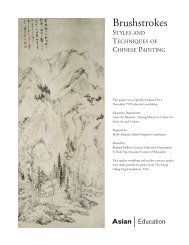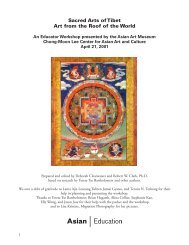Download PDF - Asian Art Museum | Education
Download PDF - Asian Art Museum | Education
Download PDF - Asian Art Museum | Education
You also want an ePaper? Increase the reach of your titles
YUMPU automatically turns print PDFs into web optimized ePapers that Google loves.
and then admires the vessel. The shape of such bowls were inspired by common rice bowls<br />
in Korea. The fact that they were so highly prized by elite Japanese baffled Koreans who<br />
viewed them as nothing more than everyday utensils. It was this very rusticity and unpretentiousness<br />
that attracted the Japanese.<br />
What is the decoration on this bowl?<br />
The crane, a common motif in much Japanese art, symbolizes longevity and Zen enlightenment.<br />
According to legend, it lives 1,000 years. It also can represent a Chinese Daoist<br />
immortal. (Mason, p. 201) Only a few Hagi wares were decorated this way. Those that bear<br />
a design are called e-Hagi or “picture Hagi.”<br />
What is Hagi ware?<br />
Hagi, located on the western coast of lower Honshu, was founded as a castle town by the<br />
Mori daimyo family during the Edo period. Notice its proximity to the Korean peninsula<br />
across the Sea of Japan. The Hagi kilns were set up by the potters brought back after the<br />
Japanese invasion of Korea in the 1590s.<br />
The first Korean potter to serve the Mori clan was Yi Sukkwang, who was ordered to Japan<br />
by the warlord Toyotomi Hideyoshi in 1593 (the first invasion into Korea). His brother, Yi<br />
Kyung and others were brought to Japan during the second invasion in 1597. The early<br />
wares produced by these potters were steeped in traditional Korean techniques, highly<br />
prized by Hideyoshi and other members of the warrior elite.<br />
The best known Hagi wares are made with a special clay called Daido, which was a white<br />
clay full of tiny pebbles giving Hagi ware a distinctive texture that was loved by collectors.<br />
In 1815, responding to the appearance of Hagi on the general market, officials issued a law<br />
reserving the special Daido clay for use only in daimyo kilns.<br />
Source:<br />
Kawano, Ryosuke. Hagi. Famous Ceramics of Japan. Vol. 11. Tokyo and New York: Kodansha,<br />
1983.<br />
<strong>Asian</strong> <strong>Art</strong> <strong>Museum</strong> <strong>Education</strong> Department
















